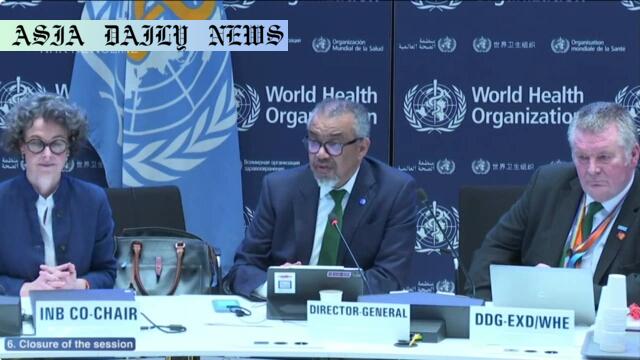Pandemic Treaty: WHO agreement marks a step forward in global defense against future infectious diseases, promoting collaboration.
Key Point 1: WHO members finalized a draft agreement on a pandemic treaty after extended discussions.
Key Point 2: The treaty emphasizes sharing knowledge and technology to benefit developing nations.
Key Point 3: A new multilateral system for pathogen information sharing is proposed.
Key Point 4: The treaty affirms national sovereignty while fostering international collaboration.
Key Point 5: Official adoption is expected at the annual WHO meeting in May.

Introduction to the Pandemic Treaty Agreement
On Wednesday, members of the World Health Organization (WHO) reached a landmark draft agreement on a pandemic treaty, marking a significant milestone in global health collaboration. This draft signifies a proactive step toward ensuring the world is better prepared to handle future pandemics, drawing heavily on the lessons learned from the COVID-19 crisis. The discussions, which began on April 7, culminated at the WHO headquarters in Switzerland, followed by online meetings to resolve disagreements on finer aspects of the treaty’s wording. The achievement paves the way for coordinated international measures aimed at safeguarding humanity against infectious disease threats.
Key Objectives of the Pandemic Treaty
The treaty is designed with a significant focus on pandemic preparedness and response. Its primary goal is to promote equitable sharing of technology and knowledge for the production of pandemic-related health products, which includes vaccines and diagnostic tools. This initiative is particularly important for developing countries that often face challenges in accessing critical health resources. By facilitating the transfer of resources and technology, the treaty aims to bridge the gap between developed and developing nations, ensuring a more unified response during global health crises.
Introducing the Multilateral Pathogen Information System
Another pivotal aspect of the draft treaty is the proposal to establish a new multilateral system for sharing information on pathogens with pandemic potential. This system is expected to serve as an essential tool for pandemic prevention and early response efforts. By creating a collaborative framework where countries can share valuable data, the treaty seeks to enable swifter identification of threats and enhance the global health system’s ability to respond effectively.
Balancing Sovereignty with Global Collaboration
The WHO has been cautious to affirm that the treaty respects national sovereignty, allowing countries to address public health matters within their borders autonomously. This assurance is crucial in securing the trust of member nations and reinforcing the idea that international agreements need not infringe upon individual countries’ rights. At the same time, the treaty fosters unprecedented collaboration and cooperation, emphasizing that health security is a shared global responsibility.
Looking Ahead: Adoption and Implications
The draft agreement is expected to be officially adopted during the annual WHO meeting in May, marking a turning point in international health governance. WHO Director-General Tedros Adhanom Ghebreyesus praised the efforts of the member nations, stating that the draft represents a significant step toward improving global pandemic readiness. If adopted, the treaty could reshape how the world responds to health emergencies, emphasizing the importance of solidarity and collective action in overcoming global health challenges.
Conclusion: A Historic Milestone in Global Health
The pandemic treaty symbolizes hope and progress in the wake of the devastating COVID-19 crisis. It underscores the necessity of international unity in addressing common challenges and striving for a healthier and safer future. By prioritizing equitable resource distribution, technological innovation, and shared responsibility, the treaty sets a foundation for stronger global health defenses, ensuring humanity is better equipped to face whatever future infectious diseases may arise.
Commentary
WHO Pandemic Treaty: A Game Changer for Global Health
The recent agreement on the draft of the pandemic treaty by WHO member nations is a profound step toward addressing one of the most critical global challenges of our era. The COVID-19 pandemic starkly highlighted the vulnerabilities in our international health systems, and this treaty reflects a collective commitment to learning from those shortcomings. Despite the hurdles and disagreements that had to be resolved, the achievement demonstrates the power of collaboration in overcoming significant global issues.
Strengthening Global Health Collaboration
One of the standout features of this treaty is its focus on fostering equitable access to health innovations, especially for developing countries. By advocating for the sharing of knowledge and technology, the agreement seeks to eliminate some of the long-standing inequities that have hampered global pandemic responses. This principle is not only ethically sound but also strategically wise, as no country can completely insulate itself from infectious diseases in an interconnected world.
The Role of Sovereignty and Collaboration
Another commendable aspect of the treaty is its respect for national sovereignty. The agreement carefully balances the need for international collaboration with the autonomy of individual nations, ensuring that local health priorities are not overshadowed. This approach is likely to win over skeptics who might view global health treaties as a potential infringement on national rights.
Long-Term Implications and Hope
As the treaty moves closer to formal adoption in May, its potential implications for global health are enormous. It could reshape the way nations prepare for and respond to pandemics, fostering a spirit of unity and shared responsibility. While challenges in implementation are inevitable, the mere existence of such a treaty signals a hopeful shift in our approach to global health crises. For a world still reeling from the effects of COVID-19, this is a much-needed beacon of optimism.


